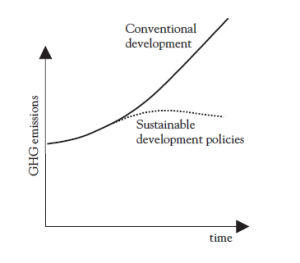Dickinson to Durban » Climate Change » Just another acronym?
Just another acronym?
By Dani Thompson
In 2002, the World Resource Institute published the report, “Building on the Kyoto Protocol: Options for Projecting the Climate.” Within this 250+ page document, there is a chapter by Harald Winkler, senior researcher at the Energy and Development Research Centre at the University of Cape Town, entitled “Sustainable Development Policies and Measures”. Like so many other climate change issues, this term was lovingly given an acronym, SD-PAM. The document, available here, looks at SD-PAM in a case study of South Africa. 
SD-PAM is a bottom-up or “pledge based approach” which focuses on promoting sustainable development in developing countries. Realizing that issues surrounding climate change are not the greatest concern for many of these countries (even though for some it maybe should be!), this approach allows for economic and developmental progress—but aims to do so in a sustainable way. There are five steps in which SD-PAM is used to evaluate this development.
1. The country looks at their priorities regarding development. Here is a list of some major objectives mentioned in the report:
- poverty eradication
- job creation
- food security
- access to renewable/efficient energy
- transportation
- drinking water
- education
- health service
- land use/availability
After prioritizing these objectives they should ask themselves, “How can these goals be achieved in a sustainable way?”
2. Identify ways this new, sustainable development relates to society. i.e. What in the SD-PAM will lead to the betterment of society, not considering a potential reduction in greenhouse gas emissions?
Things to consider here:
- What is the country already doing that is sustainable?
- What can be added to current policies which will make them stronger?
- What new policies and management practices should be considered?
3. Identify ways which SD-PAM will reduce greenhouse gas emissions and report to relevant convention/body.
4. Establish synergies between steps 2 and 3 and work to intensify these synergies.
5. Create a summary of all benefits resulting from the implementation of SD-PAM
We cannot expect to eradicate climate change without models which include sustainable development, but this will not be the only benefit of creating more sustainable lifestyles. Sustainability itself can stand alone as a tree whose branches reach out in many directions. These branches can promote growth in human health, justice and equality, education, and even the economy– reducing GHG emissions is just one of the many benefits which will result in the SD-PAM approach for developing countries.
Work Cited:
Winkler, Harald. “Sustainable Development Policies and Measures.” World Resources Institute. 2002. pp 61-89.
Filed under: Climate Change · Tags: climate change, climate change governance, Dani Thompson








Recent Comments